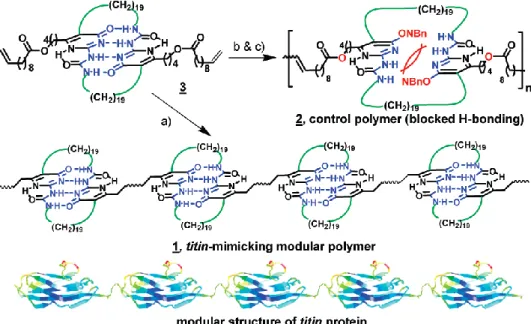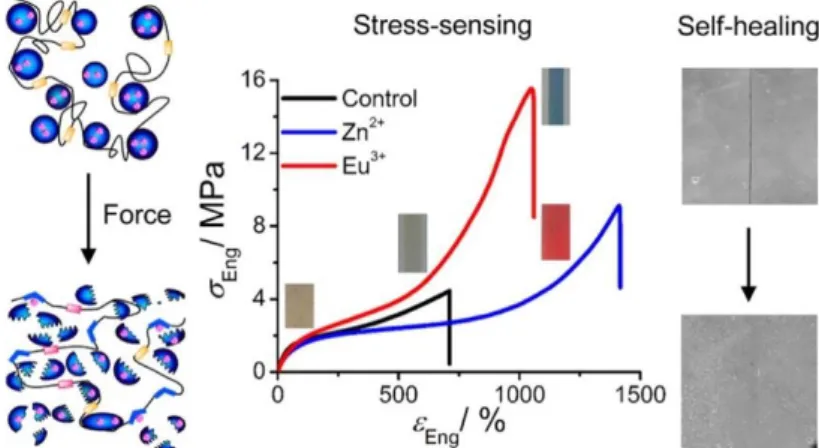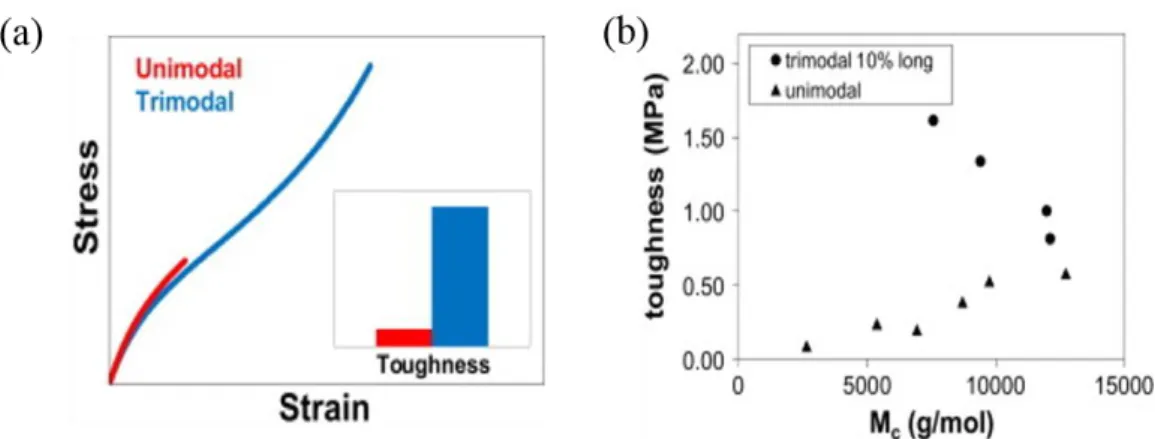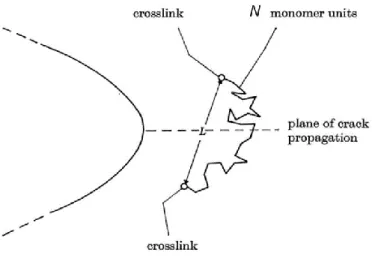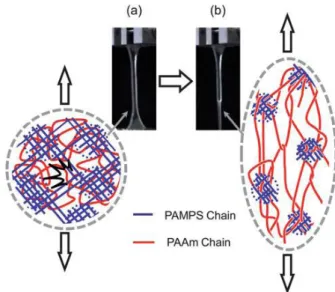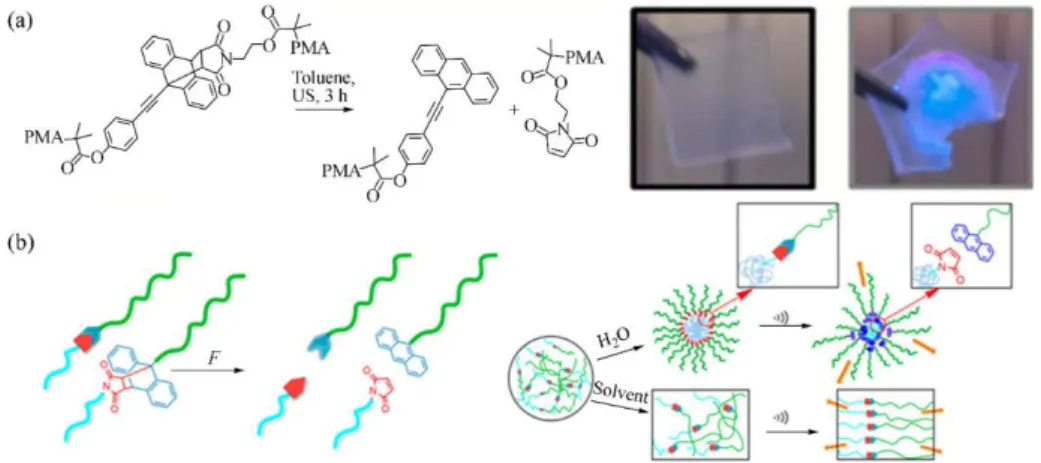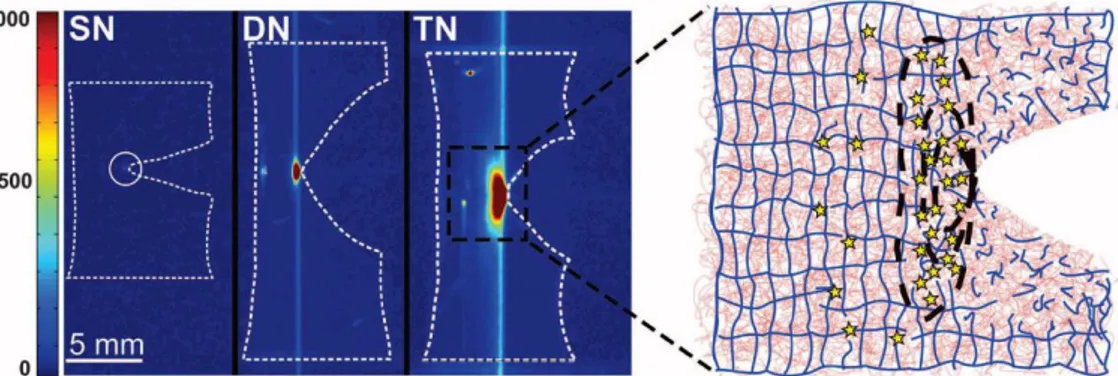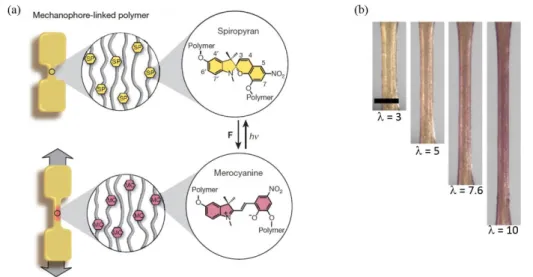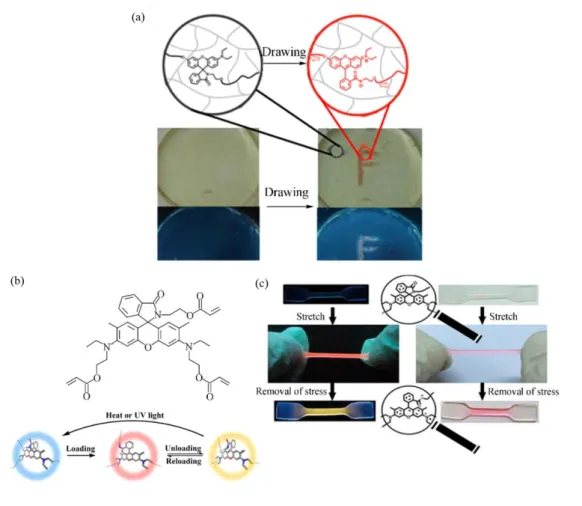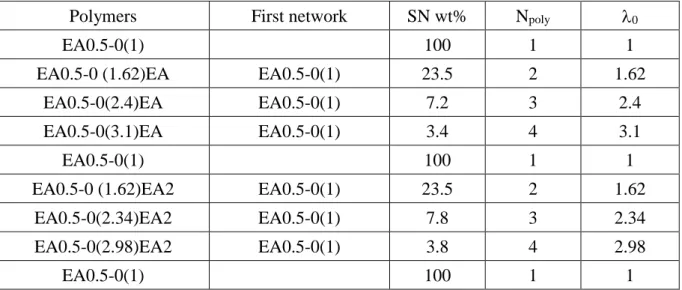HAL Id: tel-02496939
https://pastel.archives-ouvertes.fr/tel-02496939
Submitted on 3 Mar 2020HAL is a multi-disciplinary open access
archive for the deposit and dissemination of sci-entific research documents, whether they are pub-lished or not. The documents may come from teaching and research institutions in France or abroad, or from public or private research centers.
L’archive ouverte pluridisciplinaire HAL, est destinée au dépôt et à la diffusion de documents scientifiques de niveau recherche, publiés ou non, émanant des établissements d’enseignement et de recherche français ou étrangers, des laboratoires publics ou privés.
mechanochemistry
Yinjun Chen
To cite this version:
Yinjun Chen. Quantitative mapping of stress in soft materials by mechanochemistry. Chemical Physics [physics.chem-ph]. Université Paris sciences et lettres, 2018. English. �NNT : 2018PSLET014�. �tel-02496939�
THÈSE DE DOCTORAT
de l’Université de recherche Paris Sciences et Lettres
PSL Research University
Préparée à Ecole Supérieure de Physique et de Chimie
Industrielles de la Ville de Paris
Quantitative mapping of stress in soft materials by mechanochemistry
COMPOSITION DU JURY :
M. NICOLAY Renaud
ESPCI Paris, le président du jury
M. CIPELLETTI Luca
Université de Montpellier, Rapporteur
M. SIJBESMA Rint
Eindhoven University of Technology, Rapporteur
M. BICO José
ESPCI Paris, examinateur
M. FAYOLLE Bruno
Arts et Métiers Paris Tech-ENSAM, examinateur
M. CRETON Costantino
ESPCI Paris, Directeur de thèse
Soutenue par Yinjun
CHEN
le 19 Septembre 2018
h
Ecole doctorale
n°
397 Physique et Chimie des MatériauxSpécialité
Physico-chimie
Dirigée par Costantino CRETON
THÈSE DE DOCTORAT
de l’Université de recherche Paris Sciences et Lettres
PSL Research University
Préparée à Ecole Supérieure de Physique et de Chimie
Industrielles de la Ville de Paris
Quantitative mapping of stress in soft materials by mechanochemistry
COMPOSITION DU JURY :
M. NICOLAY Renaud
ESPCI Paris, le président du jury
M. CIPELLETTI Luca
Université de Montpellier, Rapporteur
M. SIJBESMA Rint
Eindhoven University of Technology, Rapporteur
M. BICO José
ESPCI Paris, examinateur
M. FAYOLLE Bruno
Arts et Métiers Paris Tech-ENSAM, examinateur
M. CRETON Costantino
ESPCI Paris, Directeur de thèse
Soutenue par Yinjun
CHEN
le 19 Septembre 2018
h
Ecole doctorale
n°
397 Physique et Chimie des MatériauxSpécialité
Physico-chimie
Dirigée par Costantino CRETON
Upon the completion of this thesis, I would like to express my gratitude to those who have offered me encouragement and support during the course of my study.
First, I would like to thank the Chinese Scholarship Council (CSC) and Centre National de la Recherche Scientifique (CNRS) for their financial support, which allowed me to realize my dream of studying in France.
A profound gratitude goes to my supervisor, Costantino Creton whose conscientious manner and modest, open-minded personality inspire me both in my academic study and daily life. Thank you for your support, encouragement and offering me the opportunity to pursue my research interests. You always helped me overcome countless difficulties with your patience and profound knowledge in the field of polymer mechanics. You will always be my role model as a supervisor, which I aim to be in the future.
Also, I sincerely express my thanks to my collaborators: Professor Rong Long and his PhD student Yuan Qi who visited from the University of Colorado. Thank you for your advice and help on the construction of the strain fields.
My thanks also go to Christian Fretigny, the director of the lab SIMM of ESPCI, for his help on my application and registration to be a PhD student.
I would like to express hearfelt thanks to all the members in my jury: Professor Rint Sijbesma, Professor Luca Cipelletti, Professor Renaud Nicolay, Professor Bruno Fayolle, and Professor José Bico. I appreciate their evaluations and suggestions on my thesis.
I am glad to work with all the members of SIMM; thanks for all your help. Thank you for organizing various amusing activities, including lab weekend, board games, parties, etc. These three years will be an unforgettable time in my life
I also want to express my appreciation to all the permanent staff members for your kind help. Especially Bruno, who gave me a lot of help on the confocal microscope and the Deben micro-tensile stage tests, and Alba, who gave me great suggestions on the Instron tensile tests.
I would like to also thank all the students in the lab for their discussion, help, encouragement, and support. Especially, I wish to thank
Robert, Pierre, Hui, Menghua, Jingwen, Thitima, Ekkchai, Juillet, Ludovic, Gabriel, Francisco, Mehdi, Cécile, Alice, Valentine, Ménani, Paul, etc.
Meanwhile, I would like to show my gratitude to my Chinese friends in ESPCI. Thank you for enriching my life in France.
I would like to extend my deep gratefulness to my family and friends, especially my parents and sister. It would have been impossible to finish my PhD journey without your support and encouragement. Thank you for your selfless love.
Finally, I am deeply indebted to my wife, Xiaoli. Thank you for your support, encouragement and patience in the past three years. Although we could not be together in France, you still supported me to finish my PhD. Thank you so much for your patience. Your love is always the source of my strength during the period of my PhD. And I love you, my sweet heart.
BA Butyl Acrylate
BDA 1,4- Butandiol diacrylate
DMSO Dimethylsulfoxyde
DN Double Network
Ea Ethyl Acetate
EA Ethyl Acrylate
HMA Hexyl Methacrylate
HMP 2-Hydroxyethyl-2-methylpriopiophenone IPN Interpenetrated Polymer Network
MC Merocyanine
NMR Nuclear Magnetic Resonance
QN Quadruple Network TMI 2,3,3-Trimethylindolenine SN Simple Network SP Spiropyran THF Tetrahydrofuran TN Triple Network UV Ultra Violet
RGB Chromatic value in Red, Green and Blue channels
𝑪∞ Characteristic ratio for an infinite number of monomers
𝑪𝑵 Characteristic ratio for N monomers
𝑴𝒙 Average molecular weight between crosslinks
𝑵𝑨 Avogadro’s number
𝒌𝑩 Boltzmann constant
𝑬𝒆 Contribution of the entanglements to the Young’s modulus
𝑬𝒙 Contribution of the crosslinks to the Young’s modulus
𝑮 Energy release rate
𝑴𝟎 Molecular weight of a monomer
𝑴𝒆 Average molecular weight between entanglements
𝑼𝑪−𝑪 Energy of a carbon bond
𝜞 Fracture energy
𝝀̇ Strain rate
𝝀𝒄𝒐𝒓𝒓𝒆𝒄𝒕 Corrected elongation
𝝀𝟎 Prestretching of the first network
𝝀 Stretch ratio
𝑾(𝝀𝑪) Strain energy density at critical strain
𝝀𝑪 Critical strain
𝝈𝑵 Nominal Stress
𝝈𝒂𝒄𝒕 The threshold of stress to activate SP
𝝌 Mixing parameter
𝛟𝑺𝑵 or ϕ Fraction of first network in multiple network elastomers
E Young’s modulus
R Gas constant
T Temperature
ν Number of elastic polymer chains per unit volume
𝝆 Polymer network density
a Length of notch
h Thickness of sample
𝒉𝑺𝑵 Thickness of single network
𝒉𝑫𝑵 Thickness of double network
L The distance between two black marks
𝑳𝟎 Initial distance between two black marks
d Width of sample
𝒓𝑩𝑪 Ratio of blue channel
𝒓𝑹𝑪 Chromatic change in red channel
𝒓𝑮𝑪 Chromatic change in green channel
𝒓𝑩𝑪 Chromatic change in blue channel
𝜮𝑭𝑵 Areal density of chains of the first network in multiple networks 𝜮𝐒𝐍 or 𝜮𝑭𝑵𝟎 Areal density of chains of the first network single networks 𝑼𝒉𝒚𝒔𝒕(𝒏) Hysteresis in the nth each cycle
𝑰𝟎 The incident light intensity
I Transmitted light intensity
General Introduction ... 1
Chapter 1- The design of robust elastomers and mechano-chemistry ... 7
Introduction ... 9
1. Traditional tough elastomers and multiple network elastomers ... 10
1.1 Nano-composite elastomers ... 10
1.2 Supramolecular interaction elastomers ... 11
1.2.1 Hydrogen bonding ... 13
1.2.2 Metal-ligand interaction ... 14
1.2.3 Host-guest interaction ... 15
1.2.4 Other kinds of super-molecular interaction ... 16
1.3 Multiple networks ... 17
1.3.1 Bimodal networks ... 18
1.3.2 Double network hydrogels ... 20
1.3.3 Multiple network elastomers ... 23
2. Theory of crack propagation ... 25
2.1 Lake-Thomas model ... 25
2.2 Brown’s model ... 27
2.3 Tanaka’s model ... 29
2.4 The fracture mechanism of multiple network elastomers ... 30
2.5 Finite element model ... 32
3. Mechanochemistry ... 33
3.1 Introduction ... 33
3.2 Optically inactive mechanophores... 34
3.3 Mechanoluminescent polymers ... 36
3.3.1 Mechanofluorescent polymers ... 36
3.3.2 Mechanochemiluminescent polymers ... 37
3.4 Mechanochromic polymers ... 39
Conclusion and motivation of the manuscript ... 45
Introduction ... 51
1. Standard synthesis of multiple networks ... 52
1.1 Chemical reagents ... 52
1.2 Polymerization conditions of the networks ... 53
1.3 Synthesis of the spiropyran (SP) cross-linker ... 54
1.4 Synthesis of the first (or filler) network ... 56
1.5 Preparation of a family of multiple networks elastomers ... 58
2. Synthesis of various multiple network elastomers... 60
2.1 Effects of cross-linking in the first network ... 60
2.2 Various SP concentrations in the first network ... 61
2.3 Different monomers in the first network ... 62
3. Characterization of multiple network elastomers ... 63
3.1 Tensile tests ... 63
3.1.1 Uniaxial extension ... 63
3.1.2 Cyclic loading tests ... 64
3.1.3 Step cycle elongation tests ... 65
3.1.4 Relaxation test ... 65
3.1.5 Fracture tests ... 66
3.2 Color analysis: basic principles10 ... 67
Conclusion ... 69
Reference: ... 70
Introduction ... 77
1. Mechanical properties ... 78
1.1 Standard family multiple network elastomers ... 78
1.2 Various stretching rates ... 80
1.3 Different cross-link densities ... 81
1.4 Behavior of samples under cyclic loading tests ... 85
1.5 Fracture energy ... 87
2. Optical response to mechanical stress... 89
2.1 Color analysis for the EA0.5-0.05 standard family of materials ... 89
2.2 The effect of strain rate ... 96
2.3 The effect of various cross-link densities in the filler network ... 97
2.4 The effect of varying the SP concentration ... 98
3. Accurate calibration of the Stress: Toward Quantification ... 99
4. Optical response in fracture tests ... 101
4.1 Optical response around the crack in EA0.5-0.05 family ... 101
4.2 Optical response around the crack for EA0.2-0.05(2.61)EA sample ... 103
5. Quantitative Stress distribution around the crack tip before propagation... 104
5.1 Stress distribution in standard multiple network elastomers ... 104
5.2 Stress distribution in various elastomers at the same energy release rate ... 106
6. Mapping the Strain Energy Density ... 109
7. Preliminary results of color change during unloading ... 111
7.1 Color change in cyclic loading ... 111
7.2 Color change during the relaxation process ... 112
Summary of Main Conclusions ... 114
Introduction ... 119
1. Construction of a color map of the stress... 120
1.1 Color change during the unloading process ... 120
1.1.1 Mechanism of color change during the unloading process ... 120
1.1.2 Color map of stress in standard multiple network elastomers ... 122
1.1.3 Multiple network elastomers with different mechanical property ... 125
1.1.4 Elastomers with various SP concentrations ... 126
2. Stress distribution around the crack tip during crack propagation ... 126
2.1 Color change during crack propagation... 126
2.2 Stress distribution in crack propagation ... 127
3. Quantify the level of activation of SP near the crack tip ... 132
Conclusion ... 134
Reference: ... 135
Chapter 5: The fracture mechanism of multiple network elastomers ... 137
Abstract ... 139
Introduction ... 140
2. Results ... 141
2.1. Mechanical properties of multiple network elastomers ... 141
2.2. Mechanical response in uniaxial extension ... 143
3. Discussion ... 146
3.1 Influence of the SP position in multiple networks ... 146
3.2. The effect of the connectivity between the first and the second network ... 148
2.3. Stress transfer to the matrix network during the crack propagation process ... 150
3.3 Higher magnification detection of the stress in the matrix network ... 151
Conclusion ... 154
Experimental section ... 154
Introduction ... 161
1. Synthesis of multiple network elastomers containing fluorescent beads ... 162
1.1 The choice of fluorescent beads ... 162
1.2 Synthesis of elastomers ... 162
2. Characterization of elastomers ... 164
2.1 The effect of fluorescent beads on mechanical properties ... 164
2.2 Confocal microscope observations ... 165
2.3 Calculation ... 167
3. Preliminary results ... 168
3.1 The vector displacement field of fluorescent beads ... 168
3.2 The strain field around the crack tip ... 169
Conclusion ... 171
References ... 172
Chapter 7. Perspective and discussion ... 173
Introduction ... 175
1. Discussion around the quantification of polymer chains involved in the damage ... 176
2. Discussion about the fracture of the first network after yielding... 177
3. The combination of the stress field and strain field around the crack tip ... 179
3.1 Calibration curve of fluorescence ... 181
Conclusion: ... 183
Reference: ... 184
1
General Introduction
2
Elastomers, a category of polymer materials, are widely used in engineering applications. Elastomers are appreciated due to their large range of reversible deformation even up to several hundred percent strain. Generally, elastomers are made of flexible crosslinked and highly entangled polymer chains. Simple elastomers, however, usually suffer from a trade-off between fracture toughness and stiffness. A pure highly cross-linked polymer network has a high initial modulus but is generally rather brittle. In contrast, a loosely crosslinked polymer network is extensible and possess a large range of reversible elasticity but has a lower Young’s modulus.
In industry, a common approach to toughen polymer materials is to use inorganic nanofillers, including carbon black, silica, carbon nanotubes, graphene etc.. Indeed, this strategy improves both toughness and stiffness by introducing new dissipative mechanisms, which involve attachment and detachment of adsorbed chains, cavitation and breakup of the interactions between fillers. However, this approach reinforces elastomers by sacrificing the transparency and increases the density of polymer materials, which limits their application in some fields where high purity, transparency or low density may be desirable. Additionally, the approach increases the difficulty of processing for product.
To circumvent the limitations derived from using nanofiller, lots of strategies have been tried to reinforce elastomer by using pure polymer networks. The main idea is to incorporate some molecular mechanisms that dissipate energy in large deformations and delocalize the damage ahead of cracks delaying their propagation. The sacrificial mechanism, so far, includes the irreversible scission of covalent bond and the reversible break-up of supramolecular interactions. Supramolecular interactions consist of hydrogen bonding, metal-ligand, pi-pi stacking, hydrophobic interactions and electrostatic interactions. These interactions act as physical cross-links and dissociate early when a force is applied and avoid sharp stress concentrations to protect the covalent bonds in the polymer network during deformation. In addition, this process of reversible dissociation/association may extend the lifetime of polymer materials by providing self-recovery capabilities. However due to the stretching rate dependence of these dissociation processes, they greatly increase the viscoelasticity of the material. Furthermore, physical interaction are generally sensitive to the external environment (temperature, UV, nature of the main polymer…), for example, hydrogen bonding dissociates at high temperature and is less effective in more polar matrix materials, causing the material to soften. That limits the generalization of the incorporation of supramolecular interaction.
3
Another class of dissipative mechanisms involving the scission of overstressed covalent bonds has attracted a great deal of interest due to the lack of viscoelastic behavior and high energy dissipation per bond. An example are multimodal networks, utilizing the heterogeneity of molecular weight of polymer chains between crosslinks (short chains and long chains) to selectively cleave the carbon-carbon bonds in the short chains to dissipate energy. But the efficiency of that strategy to toughen the elastomer is not impressive.
Over the past fifteen years, a successful solution to simultaneously improve fracture toughness and modulus of pure polymer materials emerged from the field of hydrogels. Generally, hydrogels are soft and extensible or brittle and stiff. But double network hydrogels proposed by Gong’s group are tough and extensible. They managed to reinforce hydrogels by interpenetrating a highly swollen and highly cross-linked polymer network (filler network) into a soft and extensible hydrogel. The improvement of the toughness derives from the breakage of covalent bonds in the filler network.
Inspired from the double network hydrogels, recently our group designed innovative multiple interpenetrated network elastomers. The objective was to extend the principle of double network hydrogels to the field of elastomers. By interpenetrating a highly pre-stretched and cross-linked network (which we will call filler network) into extensible multiple networks reinforced the elastomers. Etienne Ducrot in his PhD work has successfully proposed this strategy and applied it to increase the fracture toughness and elongation of multiple poly(methyl/ethyl acrylate) networks by at least 40 and 10 times, respectively. This strategy was then extended during the PhD of Pierre Millereau and he completely answered some additional questions, including the influence of cross-link density and degree of pre-stretch in the filler network on the mechanical properties, the failure of the filler network in extension. However, due to the absence of molecular models, the details of the macroscopic fracture mechanism at the molecular scale are still an open topic:
How is the stress or deformation distributed around the crack tip?
How many bond scissions in the filler network do occur around the crack tip before the crack propagates?
What is the length scale at which the filler network breaks and dissipates energy? How is the stress transferred between the different networks in extension, especially,
4
during the necking, where large amounts of the filler network are being damaged?
To answer these questions based on experiments, the best strategy is to gain insight in the fracture mechanisms of multiple network elastomers at a molecular scale. To do so, mechanochemistry is a very good novel tool. Mechanochemistry, a new approach to initiate chemical reactions by external mechanical stimuli, was developed in the last ten years. In mechanochemistry applied to soft polymer networks, mechanically responsive groups, namely, mechanophores, are incorporated into the backbone of polymer chains. When a sufficient force is applied to the polymer chain, mechanophores can be activated and induce various signals, including color change, luminescence, fluorescence etc.. These mechanophores in general are sensitive to the force and are able to sense the force field distribution in the materials. In this manuscript, spiropyran, a mechanochromic mechanophore, is used to detect the stress distribution in multiple network elastomers by its color change during activation. The manuscript is organized as follows:
In the first chapter, diverse strategies to reinforce elastomers and different mechanophores are introduced. In addition, various macro-models or hypothesis to describe and model the fracture mechanism of multiple polymer networks are also presented and will be used as reference for our results.
The second chapter introduces the synthesis of a spiropyran mechanophore cross-linker and of mechanically responsive multiple network elastomers and describes different characterization methods for multiple network elastomers.
In the third chapter, at first, the mechanical properties of the multiple networks are examined in detail. Then the relationship between the color change of spiropyran and the stress is constructed by color analysis. A calibration curve of the chromatic change as a function of stress was obtained to map the stress distribution in the elastomers. Finally, the stress maps of different materials display the evolution of the stress field around the crack tip prior to propagation.
In chapter four, the reversible color change of spiropyran once it has been converted to Merocyanine is being discussed. We show that two different isomers of Merocyanine, with slightly different absorption spectra, can be present in the materials depending on whether the bond is loaded or unloaded. These results are then used to map the unloaded areas behind the crack tip during propagation.
5
In chapter five, spiropyran was incorporated into the second/third network to detect the onset of high tensile stresses in this network, which occur after the filler network is highly damaged but before the sample macroscopically breaks. Furthermore, the role of the second/third network in the resistance to crack propagation was also studied by detecting the fluorescent signal of active spiropyran.
Then in the sixth chapter, a new approach to map the strain field around the crack tip by tracking fluorescent beads was carried out and its potential to obtain accurate data was assessed.
In the seventh chapter, we discuss the results we have obtained throughout this manuscript and the perspectives which we can open up in the future to deepen the understanding of the fracture mechanism.
In the last part, a general conclusion is proposed to summarize the main achievements obtained in this manuscript and the contribution to the understanding of the fracture mechanism in multiple network elastomers.
7
Chapter 1- The design of robust elastomers and
mechano-chemistry
8
Chapter 1- The design of robust elastomers and mechano-chemistry ... 7 Introduction ... 9 1. Traditional tough elastomers and multiple network elastomers ... 10 1.1 Nano-composite elastomers ... 10 1.2 Supramolecular interaction elastomers ... 11 1.2.1 Hydrogen bonding ... 13 1.2.2 Metal-ligand interaction ... 14 1.2.3 Host-guest interaction ... 15 1.2.4 Other kinds of super-molecular interaction ... 16 1.3 Multiple networks ... 17 1.3.1 Bimodal networks ... 18 1.3.2 Double network hydrogels ... 20 1.3.3 Multiple network elastomers ... 23 2. Theory of crack propagation ... 25 2.1 Lake-Thomas model ... 25 2.2 Brown’s model ... 27 2.3 Tanaka’s model ... 29 2.4 The fracture mechanism of multiple network elastomers ... 30 2.5 Finite element model ... 32 3. Mechanochemistry ... 33 3.1 Introduction ... 33 3.2 Optically inactive mechanophores ... 34 3.3 Mechanoluminescent polymers... 36 3.3.1 Mechanofluorescent polymers ... 36 3.3.2 Mechanochemiluminescent polymers ... 37 3.4 Mechanochromic polymers ... 39 Conclusion and motivation of the manuscript ... 45 Reference : ... 46
9
Introduction
A great number of approaches have been proposed by material scientists to design tough elastomers, including of course introducing nanofillers, but also introducing dynamic cross-links or interpenetrated multiple network structures. For interpenetrated multiple networks, despite numerous macroscopic theories which have been proposed to explain the mechanism of reinforcement1-5, and which work well, a molecular model to understand the increase in toughness and the fracture is still missing. Due to the heterogeneous network6-10, some side reactions during polymerization (including chain transfer reaction11,12) and polymer entanglements11,13,14 etc., the stress and deformation in the polymer network is
inhomogeneous. Thus the understanding of mechanical strength and fracture propagation in elastomers is still a challenge.
The main purpose of this work is to develop a new method to measure the stress and strain distribution near the crack tip in multiple network elastomers by using a molecular force probe.
In this chapter we first review the state of the art concerning the various strategies to improve the mechanical properties of elastomers. We present the strategies of nanofillers, supramolecular interactions and interpenetrated multiple networks to toughen elastomers. In the second part we introduce the models of fracture propagation in elastomers, including the special case of interpenetrated double networks. We list some existent and reliable models to explain and predict the reinforcement mechanism for the interpenetrated double networks. In the third part, we review the chemistry of diverse mechanophores, which are able to emit luminescence and to modify their absorption spectrum under mechanical activation. Being introduced in the elastomer network, these mechanophores can be used as molecular force probes.
Finally, we formulate the motivation of this thesis and the approach applied to detect the fracture in multiple network elastomers.
10
1. Traditional tough elastomers and multiple network elastomers
Commercial elastomers are polymer materials that possess a high range of reversible elasticity and generally a high fracture toughness. Most of elastomers consist of polymer chains and cross-linkers. They can be imaged as a flexible and extensible “fishing net” structure and their elasticity derives from their structure. The polymer chains are able to reconfigure themselves to distribute an applied stress and the covalent cross-linkers ensure that the elastomers can return to their original configuration. Due to their low density and outstanding mechanical properties at high deformations, elastomers usually are used as seals, tires, adhesives, shoe soles, etc. different applications from those of metals, ceramics or polymer glasses. The excellent mechanical properties of elastomers are due to their unique molecular and microstructure. During the deformation of the elastomer network, not only reversible deformations occur but also various dissipative processes can take place, including the scission of physical and/or chemical interactions. These dissipative processes have been shown to be essential in delaying crack nucleation and propagation and result in the improvement in stress at break and fracture toughness4,15. Due to the tremendous demands of application for tough elastomers, intensive researches have been carried out to reinforce them and the material structure has been shown to be the key factor of reinforcement. These structures can be mainly separated into three groups: nano-composite elastomers, supramolecular interaction elastomers and multiple network elastomers, which are shown in Figure 1.1.
Figure 1.1: Schematic of various tough elastomers
1.1
Nano-composite elastomers
In this toughening strategy, a wide variety of nano scale fillers can be covalently or physically incorporated into elastomers. The nanofillers may have strong or weak interactions with the polymer network and they act as additional multifunctional permanent or transient cross-links. Different from chemical cross-links, the transient cross-links are mobile, and allow some chain rearrangement during loading at high strain. This leads to strong energy dissipation which will delay the nucleation of micro-cracks.
11
In general, diverse nanofillers have been applied to prepare tough elastomers16, such as nanoparticles17-20, carbon nanotubes21, graphene22-24 and fibres25. For instance, silica and carbon black nanoparticles, are widely applied in the industry for reinforcement. It has been proven that the degree of improvement of toughness by introducing nanofillers depends on the surface properties, size and volume fraction of fillers26. A classic example is given in Figure 1.2, where carbon black is used to reinforce the mechanical properties of natural rubber for the fabrication of tires. The reinforcement depends on the degree of aggregation of carbon black individual particles and on the interaction between carbon black and polymer chains. The aggregates of carbon black form a second network26, as it has been originally proposed by Payne and Whittaker27 and the filler network is weakly held together by Van der Waals’ interactions. The interaction between filler and polymer chains is mainly by physical absorption. Upon deformation, the network of fillers reorganizes, which leads to high dissipation of energy. The introduction of a filler greatly increases the stress at break and fracture toughness without reducing the strain at break.
Figure 1.2: SEM photograph of carbon black in natural rubbers28
However, although nanofillers improve the mechanical properties of elastomers, the transparency of the materials is often lost and imposes constraints on the processing parameters and increases the density. That limits the application of polymer materials in some fields, where transparency is important. Therefore, other approaches were proposed without fillers.
1.2
Supramolecular interaction elastomers
Thermoplastic polyurethanes, a category of polyureas, are commercial and tough elastomers without nanofiller additives and have found widespread engineering application. However, their reversible elasticity is less than for conventional elastomers and when they are deformed in large strain they typically retain some residual deformation after unloading. The advantage of these thermoplastic elastomers is on the other hand their reprocessability due to the absence of permanent crosslinks.
12
To tune the balance or properties, one of the effective approaches has been to incorporate various supramolecular interactions into the polymer network. These segments are able to associate due to supramolecular (non-covalent) bonds, acting as transient cross-linkers. These transient (“physical”) cross-linkers may coexists with permanent (“chemical”) ones formed by covalent bonds. The strength of supramolecular interaction ranges between that of covalent bond and Van der Waals’ interactions. For example, the dissociation energy of hydrogen bonds is about 8-35 kJ/mol and the dissociation energy for Carbon-Carbon (C-C) is 347 kJ/mol. This suggests that the physical cross-linker is non-permanent and easier to dissociate with respect to the chemical one. This leads to the increased mobility of the polymer chains linked by the physical cross-linker. Unlike the pure chemically cross-linked polymer network, the elastomers with hybrid cross-links (physical and chemical) are tough due to the transient associations and have improved resistance to crack propagation. At the same time, the presence of permanent cross-links in the same network, gives them shape memory property. Since the degree of association of the physical cross-linkers can be controlled by the external environmental conditions (temperature, light, etc.), it opens the way to synthesize stimuli responsive elastomers.
According to the literature published in last two decades, supramolecular interactions commonly used in polymer materials can be separated into four categories (Table 1.1): hydrogen bonding, metal-ligand interactions, host-guest interactions and π-π interactions etc. The following sections show examples of materials based on each type of interaction.
Table 1.1. Types of supramolecular interactions used for the elaboration of tough elastomers
Supramolecular type Examples Interaction References
Hydrogen bonding NH N O H N H N O O HN N O N H N H O O Multiple hydrogen bonding 30-33 Metal-ligand N O N N N N N O N N N N Zn 2+ Coordination bonds 34-36 Host-guest N N Br N N N N H H O O CH2 CH2 8 Electrostatic interaction Or Hydrophobic interaction 38 Other kinds N N O O O O R R π-π stacking interaction 41,42
13
1.2.1 Hydrogen bonding
Hydrogen bonding is an electrostatic attraction between a hydrogen atom and electronegative atoms, such as nitrogen, oxygen or fluorine. Nitrogen and hydrogen elements are present in proteins, DNA, glycogen etc. natural products, where they induce strong hydrogen bonding interactions and are responsible for the formation of multilevel structures and double helixes. In order to imitate biological processes, various hydrogen-bonding moieties can be introduced in the polymer chains. For instance, Meijer et al.29-31 designed and synthesized the
ureidopyrimidinone (UPy) group, which is a quadruple hydrogen bonding unit. Two UPy groups are able to assemble to form dimers. When UPy groups were incorporated into the polymer chains as endgroups, each two UPy units coming from different polymer chains were able to aggregate into UPy dimers, which was called supramolecular polymerization. In addition, the polymer chains can self-assemble into fiber structures by forming dimers stacks as shown in Figure 1.3b. Similar to nanocomposites, the fibers remarkably improve the mechanical properties, which leads to solid-like behavior of materials with UPy while non-modified polymers behave as a liquid (Figure 1.3a).
Figure 1.3: (a) Behavior of polymer materials before and after modification by UPy moieties. (b) AFM image of polymer materials with UPy moieties31,32
Utilizing the same hydrogen bonding moieties, Guan et al.33 synthesized a cyclic UPy core and converted it to a terminal diolefin monomer, which was further used to prepare polymer materials (Figure 1.4). Compared to the brittle control sample without hydrogen bonding motifs in the main chains, the polymer exhibits a rare combination of high modulus and high toughness resulting in the dissipation of the dissociation of hydrogen bonding. Additionally, it also shows other properties, including self-healing and shape memory. They demonstrated the first biomimetic modular polymer materials displaying a great combination of high toughness and modulus. Moreover, the polymer exhibits self-healing and shape memory behavior.
14
Figure 1.4: Aggregation of UPy dimer in the polymer chains and imitation of titin protein33
1.2.2 Metal-ligand interaction
Generally , a metal-ligand interaction describes the coordination complexes between a transition metal and π-donor ligands. The ligand acts as a donor of an ion pair to the metal d orbitals and the metal center can form multiple coordination bonds. The coordination bond can be very stable but still responsive to light, solvent or heat. These stimuli will cause temporary dissociation of the metal-ligand motifs. When the ligand is covalently coupled into the end group of the polymer backbone, the polymer undergoes supramolecular polymerization through metal-ligand interaction. On the other way, if the ligand is located in the middle of the polymer chains, metal-ligand association will act as physical cross-linkers by forming intermolecular cross-links or intramolecular loops.
Rowan et al.34,35 modified 2,6-bis(1’-methylbenzimidazolyl) pyridine (Mebip) ligands at the end of poly (ethylene-co-butylene) chains. These end-functionalized materials showed good mechanical properties and also showed efficient defect healing under ultraviolet light. Figure1.5 illustrates how low molecular weight polymers with ligand end groups are cross-linked through metal-ion binding and form a polymer network. Under a transmission electron microscope (TEM), the materials show a pronounced microphase separation.
15
Figure 1.5: The association of Tridentate ligand 2,6-bis(1,2,3-triazol-4-yl)pyridine modified on the terminal of polymer chains and TEM image of resulting phase separation35.
Extensive studies of metal-ligand super-molecular interactions have been carried out on poly(urethane) by Weng et al36. The tridentate ligand 2,6-bis(1,2,3-triazol-4-yl)pyridine was incorporated into the polymer backbone to prepare ligand macromolecules. Upon coordinating with transition metal ions (Zn2+ and Eu3+), the materials show a rare combination of high modulus, good toughness and high deformability and self-healing capability in the presence of solvent (Figure 1.6).
Figure 1.6: Reinforcement and self-healing of polyurethane by metal-ligand interactions36
1.2.3 Host-guest interaction
Host-guest interaction is another class of supramolecular associations, where one component are host molecules and the other component are guest molecules. Typical host molecules are cyclodextrins, crown ethers, pillararenes and cucurbiturils etc. cyclic molecules forming a large cavity and guest molecules mainly including some ammonium salt frequently possess a
16
cationic group37. This two categories associate to form complexes. They are often utilized to form a supramolecular binding motif and serve as a tool for the fabrication of various self-assembled structures, such as micelles, nanotubes nanorods, nanosheets and vesicles37. If the functional groups are introduced in the polymer chains, they can act as non-covalent supramolecular cross-linkers upon complexation. Moreover, the association is controlled by experiment conditions (temperature, pH, ionic strength). This dynamic and reversible properties of host-guest interactions brings excellent stimuli-responsive features to the resultant elastomers.
Due to their advantages described above, Scherman et al38. covalently grafted cucurbit[8]uril on the side chains of a loosely cross-linked polymer network. In this system, the host-guest interaction was used to form sacrificial bonds which improved the fracture resistance, fatigue resistance and energy dissipation, which was achieved by the dynamic disassociation/re-association of the cucurbit[8]uril complexes (Figure 1.7).
Figure 1.7: (a) Schematic of a modular dual network composed of host-guest interactions and chemical cross-linkers; (b) a typical modular section of titin structure; (c) schematic of mechanical induced dissociation of CB[8] host-guest complexes38.
1.2.4 Other kinds of super-molecular interaction
Phase separation interaction and π-π stacking interactions are another two types of supramolecular interactions which have been used in polymer materials in the past few decades. These interactions trigger supramolecular assembly. They produce a variety of well-aligned anisotropic structures39, such as fibers, spheres, cylinders and lamellae etc. which form ordered micro-phase structures at longer range. These secondary structures enhanced
17
toughness of elastomers. Weng and his coworker40 fabricated different PnBA-PS-PnBA triblock copolymers and adjusted the length of PS to tailor the mechanical properties of elastomers. Suitable length of polymer chains allows them to assemble into a spherical structure, which improves the toughness of these thermoplastic elastomers.
Using on the π-π stacking interaction of pyrene derivatives, elaborated polymers have been synthesized by Colquhoun, Rowan and their coworkers41. The polymer chain-segment is
composed of two naphthalene-diimide unites, as shown in Figure 1.8a. When they increased the concentration of naphthalene-diimide units, it resulted in a progressive increase in binding constant of 2 orders of magnitude. Furthermore, an unexpected enhancement of toughness and self-healing ability was observed when the naphthalene-diimide units were separately incorporated into two polymer chains as illustrated in Figure 1.8b.
Figure 1.8: (a) Scheme representation of π-π stacking supramolecular interaction; (b) polymer containing naphthalene-diimide units on the backbone 41
Many additional studies about π-π stacking interaction, hydrogen bonding, metal-ligand etc. supramolecular chemistry have been carried out more recently and the last several decades have witnessed great progress in the utilization of supramolecular interactions to control self-assembly and architecture of tough elastomers42. However, these supramolecular elastomers are generally strongly viscoelastic due to the dynamic association of supramolecular interaction making it difficult to obtain fully reversible elasticity and fatigue toughness.
1.3
Multiple networks
In the previous section, we described some approaches to develop tough elastomers through the incorporation of nanoparticles to form nanocomposites and the use of supramolecular or coordination chemistry to obtain self-healing properties. In this section we present an alternative approach to make unfilled elastomers with minimal viscoelasticity but a higher
18
toughness through network design. In this type of approach covalent bonds are used as ‘sacrificial bonds’. Here, the term of sacrificial bond means that during the extension of the polymer network a fraction of the covalent bonds in the polymer network are overloaded (through network design) and can rupture and dissipate energy before the macroscopic failure of the material occurs. Compared to supramolecular interactions, the rupture of embedded covalent bonds can dissipate more energy per bond due to their higher bond association energy but typically cannot be easily reformed.
In this section, we present several approaches to design the networks in order to introduce such sacrificial bonds (Table 1.2). First, we will introduce the concept of bimodal networks which is known from the end of last century. Next, we present a general reinforcement strategy using the double network structure which was first invented for hydrogels. Finally, we focus on the extension of this method to multiple network elastomers developed by our group to synthesize soft but tough materials.
Table 1.2. Different kinds of polymer networks
Types Bimodal networks Double networks Multiple networks
Scheme
Examples Mark’s group43 Gong’s group44 Creton’s group15
Mechanical property Brittle tough Robust
1.3.1 Bimodal networks
Monomers, oligomers, and cross-linkers are used to synthesize polymer networks by various polymerization reactions. In non-controlled types of polymerizations of networks, the molecular weight of the polymer chains between two neighboring cross-links varies significantly due to side reactions or to the random activation and termination of the polymerization reaction. When only one kind of monomer and cross-linker are used in polymerization (or when they possess similarly reactivity), the distribution of the length of polymer chains between two cross-links is unimodal. When the polymer network is submitted to an external stress, the shortest chains and more extended chains in the polymer network break first. These chains are considered to be the ‘culprits’ in causing fracture of elastomer materials by nucleating macroscopic defects.
The term bimodal network means an elastomer with two populations of polymer chain length between the cross-links. For the population of short chains, it is easy to reach their maximum elongation and their rupture dissipates efficiently the energy. In principle if both populations were bicontinuous, the bimodal polymer network should perform as a tough material. For example, a PDMS bimodal network was synthesized by Mark et al43. They polymerized two
19
kinds of PDMS precursor polymers with different chain lengths with alkoxy and hydroxyl (or vinyl) end-groups, respectively. The bimodal polymer networks were prepared through the chemical reaction between alkoxy and hydroxyl end groups. Adjusting the ratio of short /long polymer chains, they compared a series of bimodal network elastomers (Figure 1.9). However the desired significant reinforcement of the ultimate properties and of the fracture toughness was not very large compared with the unimodal network. This was presumably due to the fact that the short and long chains phase separate and form distinct regions.
Figure 1.9: Schematic of bimodal network in which the short chain are drawn in heavier43 More recently, Cohen et al45,46. utilized vinyl-terminated precursor chains with average molecular weights of 800-8500-91000 g/mol and a tetrakis(dimethylsiloxy)silane cross-linker to synthesize trimodal networks. Compared with the unimodal networks with a similar modulus, the trimodal networks achieved a higher toughness and elongation at break (Figure 1.10), but these networks are still too brittle for industrial applications. Therefore, other strategies to design covalent networks are desired to achieve significant improvement of the fracture toughness of “unfilled” elastomers.
Figure 1.10: (a) The schematic view of stress-strain curves of unimodal and trimodal networks; (b) the toughness of trimodal and unimodal networks as a function of molar mass between effective cross-linker45
20
1.3.2 Double network hydrogels
Hydrogels, have attracted a great interest in the past few years due to their potential use for artificial soft tissues. Conventional hydrogels are composed of a single network of hydrophilic polymer swollen in water and are usually very brittle, like fragile jellies, which may seriously restrict the application. This is particularly true in applications in which the mechanical properties are essential, such as articular cartilage, semilunar cartilage, tendons and ligaments and other connective tissues.
During the last decade, a great breakthrough has been achieved by Gong’s group44 in the
design and synthesis of a particular class of tough hydrogels defined as double networks (DN) hydrogels. A double network hydrogel is a heterogeneous network (IPN) consisting of interpenetrated polymer networks synthesized sequentially (Figure 1.11), which is different from a conventional hydrogel. A DN hydrogel typically contains 80-90 weight percent of water, yet its toughness is comparable to that of conventional unfilled elastomers. The tough DN hydrogels were synthesized for the first time in 2003 by Gong and her coworkers using two sequential steps of photo-polymerization44. At first, a densely cross-linked polyelectrolyte
(poly(2-acrylamido-2-methylpropanesulfinic acid (PAMPS)) network was synthesized by a UV-initiated polymerization carried out at a very slow polymerization rate in the glove box, and then this single network was swollen by a neutral monomer (acrylamide) solution containing a very low concentration of cross-linker and initiator. When the single network was swollen to equilibrium, a double network was obtained by performing a second UV-polymerization on the swollen PAMPS single network. The swelling in the second step caused the densely cross-linked first network to become isotropically stretched and to almost reach the maximum extensibility of the polymer chains between two cross-linkers. Therefore, the first network is stiff and the second network is soft and extensible because of its low chemical cross-link density. According to Gong’s research, the essential features of tough DN hydrogels are due to the structure and the mechanical properties of first and second network6, which can be summarized into three points as follows:
(1) The mechanical behavior of the first network is stiff and brittle, such as that of a highly stretched polyelectrolyte. On the contrary, the second network is soft and ductile such as an unstretched neutral polymer.
(2) The second network forms the majority of the DN hydrogel (about 90%).
(3) The DN possesses a highly stretched first network and a loosely cross-linked second network.
21
Figure 1.11: The schematic view of the interpenetrated double network hydrogels47
Following these principles, a series of tough DN hydrogels with various compositions were prepared by Gong’s group. For instance, the DN hydrogel of PAMPS/PAAm shown in Figure 1.12. Here, PAMPS, PAAm and PAMPS/PAAm stand for poly (2-acrylamido-2-methylpropanesulfonic acid), polyacrylamide and double network, respectively. The materials were tested in uniaxial compressive and tensile tests. PAMPS/PAAm DN showed much higher stress and strain at break compared to PAMPS and PAAm gels. Compression data illustrates that highly cross-linked PAMPS is brittle as expected. On the other hand, loosely cross-linked PAAm is soft and can be highly deformed. Whereas DN of PAMPS/PAAm remains quite extensible but shows obvious strain hardening leading to high stress at break. Figure 1.12b illustrates that the PAMPS gel is brittle and breaks during the compression process, while the DN gel is tough and is able to sustain a stress of 17.2 MPa under compression despite the presence of 90 wt% of water.
Figure 1.12: (a) The compression stress-strain curves of hydrogels including PAMPS, PAAm and DN of PAMPS-PAAm; (b) The images of PAMPS and DN of PAMPS-PAAm under compression44: PAMPS, SN gel, breaks easily and PAMPS-PAAm DN gel can sustain up to =75%.
Figure 1.13 shows the uniaxial extension test performed on a of PAMPS/PAAm DN hydrogel.6,44 For this sample, one observes a necking process which leads to two strain
22
hardening regimes. The presence of a necking extends the maximum strain of the DN before rupture. In cyclic loading, when comparing the first and second cycle, the DN shows a large hysteresis and after the first cycle the sample becomes fairly soft, because of an internal fracture of the first network embedded in the DN. Based on the results obtained by small angle neutron scattering (SANS), the neutron scattering pattern from the DN hydrogels in the deformed state is anisotropic. Thus it is assumed that in the necking area the first network ruptures into numerous clusters which play the role of physical cross-linkers for the second network. The details of the fracture mechanism of the DN will be discussed in the next section.
Figure 1.13: The necking process of DN hydrogels during the stretching process6
The fracture of polymer networks usually starts by the breakage of the shortest chains. In order to avoid this effect, Sakai and Gong et al.7 prepared a well-defined “homogeneous” first network using an end-group reaction (Figure 1.14a), similar to the synthesis of bimodal elastomers by Mark43. To ensure the swelling ratio of the first network made from a neutral
polymer, a “molecular stent” method was proposed for the synthesis of tough DN48. The molecular stent method is a technique to synthesize tough DN hydrogels based on a neutral first network. In this technique, linear, strong polyelectrolyte chains or ionic micelles are introduced in the neutral first network48. Comparing the nominal tough DN hydrogels made from a heterogeneous first network, with this DN hydrogel made from a more homogeneous first network, both possess almost the same toughness, but a different initial modulus and hysteresis ahead of the necking region as shown in Figure 1.14b. The difference in the hysteresis is due to the better homogeneity of first network. Before yielding, the DN with a homogeneous first network shows much less evidence of fracture of polymer chains. This also leads to a lower reduction of the Young’s modulus after yielding in cyclic loading tests.
23
Figure 1.14: (a) The schematic of the synthesis of DN hydrogel with homogeneous first network; (b) the stress-strain curves of homogeneous and inhomogeneous DN hydrogels7
The interpenetrating DN concept is a powerful approach to toughen hydrogels and is promising for other materials. In the next section we present the interpenetrated multiple network elastomers proposed by Ducrot and Creton15 in our group.
1.3.3 Multiple network elastomers
Inspired by the interpenetrated network of DN hydrogels, our group developed a new approach to prepare tough elastomers by using interpenetrating multiple networks without solvent. Different from previous double network elastomers made by Mark49, Yoo50, Baysal et al.51, multiple network elastomers possess a highly pre-stretched first network, which is usually constituted of short, stretched polymer chains with a high cross-link density. Etienne Ducrot52 and Pierre Millereau11, two doctors who graduated from our group, studied the effect of the first network on the mechanical properties of elastomers. In Figure 1.15a, a significant improvement in Young’s modulus, the stress at break and toughness is observed for the multiple networks elastomers. The results indicate that this approach is promising to make tough elastomers. Furthermore, the elastomers toughness increases with the number of interpenetrated polymer networks. Figure 1.15b shows the mechanical performance of DN elastomers with different cross-link densities of the first network, and the results further indicate the critical relationship between the mechanical properties of elastomers and cross-linker density of the first network. The more densely cross-linked is the first network and the higher is the Young’s modulus.
24
Figure 1.15: (a) The stress-strain curves of interpenetrated multiple network elastomers; (b) the stress-strain curves of DN elastomers with various cross-linker density in the first network15
Pierre tailored the level of pre-stretch in the first network by using some solvent during the preparation of the second or additional networks. The results of the extension tests illustrate that elastomers become more and more robust (Figure. 1.16) with a high modulus and fracture toughness. Moreover, although the same monomer composition is used between the first network and the other networks (second, third network), all the elastomers have outstanding mechanical properties. The comparison of the results suggests that the reinforcement of multiple network elastomers originates mostly from the pre-stretched polymer chains in the first network which can fail without a macroscopic breakage of the whole material.
Figure 1.16: The stress-strain curves of multiple network elastomers with different pre-stretch in the first network11.
In this section, we described how the concept of DN hydrogels can be extended to the reinforcement of elastomers. A difference with hydrogels is that we developed multiple steps of swelling and polymerization (as opposed to only two) and showed that even if the same or
25
similar monomer was used to prepare the first and second networks, the enhancement in the mechanical properties for multiple network elastomers is still particularly significant.
2. Theory of crack propagation
The fracture of elastomers is difficult to model and the fracture energy is currently very hard or impossible to predict from the knowledge of its molecular structure alone due to the presence of entanglements and the heterogeneity of the polymer network. There are a large proportion of theories that are proposed based on an ideal polymer network structure as the Lake-Thomas model. Recently, several models were constructed to explain and predict the reinforcement of DN hydrogel, as listed in Table 1.3. Thus in this part we introduce several theories about the calculation of the dissipated energy during crack propagation.
Table 1.3. Introduction of various model applied in DN gels
Names Lake-Thomas
model
Brown’s model Tanaka’s model
schematic Equations Γ = 2 ∗ ΣN𝑈𝐶−𝐶 Γ 𝑔𝑙𝑜𝑏𝑎𝑙 = 4 ∗ Γ1Γ2 (𝜆𝑚− 1)𝐸2Δ𝑏 Γ𝑔𝑙𝑜𝑏𝑎𝑙 = Γ2+ 𝜎𝑐𝜀𝑐ℎ
Application conditions ideal polymer network
double networks double networks
Dissipation energy(J/m2) 10 400 100
(: fracture energy; 1, 2: toughness of the first and second network in DN; N: number of
monomer between two neighbor cross-linkers; ∑: areal chain density of chains crossing the fracture plane; Uc-c : the energy of C-C bond; E2: Young’s modulus of the second network;
m: the maximum strain of the second network; b:the width of micro-crack; σc: the critical
stress of yield; c: the critical strain of yield.)
2.1
Lake-Thomas model
The classical Lake-Thomas model2 predicts the threshold fracture energy in an ideal homogeneous single polymer network. Figure 1.17 shows schematically a polymer chain composed of N monomers between two cross-linkers located at the crack tip. During the crack propagation along the dotted plane, all the polymer chains crossing the plane are being cut. The minimum energy to break a bond is the bond energy. However, the key idea in the Lake and Thomas model is that all the C-C bonds in the polymer strand between two cross-linkers irreversibly lose their energy as the strand breaks and contribute to the dissipation of energy.
26
Assuming that these bonds are stretched to the same level as the broken one, the fracture energy c of one polymer strand equals to 2NUc-c, where 2N is the number of C-C bond
between two cross-linkers and Uc-c is the energy of C-C bond. The factor of 2 means every
monomer contributes two C-C bonds for the strand. In addition, the areal chain density ∑ which is the bulk density of polymer strands times the average distance between strands d divided by two, can be calculated by Eq. (1), where E, 𝐶∞, a, 𝑘𝐵 and T are the Young’s
modulus, the structure factor of the polymer chain relating end-to-end distance with number of monomers, the length of C-C bond, the Boltzmann constant and temperature, respectively.. Therefore, the total fracture energy can be calculated by Eq. (2).
Figure 1.17: Schematic of a polymer chain across the plane of crack propagation
Σ =
𝑎𝐸√𝐶∞𝑁6𝑘𝐵𝑇
Eq. (1)
Γ = 2 ∗ ΣN𝑈
𝐶−𝐶Eq.(2)
In this model, it is assumed that the fracture energy is only dissipated by the breakage of covalent bonds in the fracture plane and that before crack propagation the polymer material is elastic. However, in the DN or in real networks there are mechanisms of energy dissipation in the bulk, which may lead to a distinct hysteresis in a cyclic loading6. For instance, DN gels described above show significant hysteresis in the first cycle loading. Recently, Creton et al.9
discussed the deviations observed for DN elastomers from the Lake-Thomas model. Figure 1.18 shows a sketch of the heterogeneous structure of the real single network. It is likely that the shortest polymer strands near the crack tip break first in the cross-linked regions. Therefore, when a crack propagates through this structure the flaw probably follows the shortest strands distribution in densely cross-linked regions instead of a straight and defined plane. In this process, more bonds are likely to break and a larger energy can potentially be dissipated.
27
Figure 1.18: Schematic of a heterogeneous network with a plane (dashed line) of fracture and circles showing the preferential fracture of short strands
Although the Lake-Thomas model is inapplicable by itself for DN gels, it defines the process of crack propagation and provides an estimate of the minimum tear energy for a polymer material.
2.2
Brown’s model
To quantify the reinforcement in the fracture energy due to the DN special structure, several attempts have been carried out1,3,4,53. Such as the molecularly based model proposed by Hugh R. Brown (called Brown’s model) targeted at explaining the necking in DN hydrogels. This model1 is based on the Lake-Thomas theory but includes the number of strands caused by the enhancement of the distinctly unusual DN microstructure. In this model crack propagation occurs in two stages. First, the stiff and brittle first network breaks under the external stress due to its high degree of stretching and dense cross-linking density. This happens before necking and leads to the formation of internal micro-cracks. The Brown microcrack is imagined with a defined length “a” and width “b”, as shown in Figure 1.19 and the space inside it, is bridged by the second network strands to retain the continuous structure of the sample. If we assume the second network to be linearly elastic, the strain energy release rate G can be calculated from the far field average stress “σ” by Eq. (3)
G =△ bσ/2 Eq. (3)
The maximum width of the micro-crack should be of the order the contour length of the strand in the second network. This means a contour length of 3 µm typically contain about 10000 repeating chain units for a PAAm second network. For a first network with the toughness of 0.5 J/m2, Eq. (3) gives a critical stress value of 0.3 MPa to nucleate a micro-crack, which is very close to the experimental value of 0.2 MPa for the necking stress.
28
Figure 1.19: Schematic representation of a micro-crack in the first network of a DN1
The second step is a crack propagation in the second network which leads to the failure of sample. When the external stress increases above σ, more micro-cracks are formed in the region around the crack tip, as shown in Figure 1.20a. In this region, the elastic properties of the material is similar to those of the second network because of the strong damage of the first network in this zone. This zone has a much lower modulus E2, when compared with the zone
far away from the crack tip, where the modulus E1 is mainly controlled by the undamaged
first network. As a consequence, when the crack propagates within the second network, it can be modeled as a pure shear fracture. During this second step the critical strain energy release rate ’ can be given by Eq. (4).
Γ′ = h(𝜆
𝑚− 1)
2𝐸
2/2 Eq. (4)
Where “h” is the unloaded width of the damage zone, 𝞴m is the maximum deformation of the second network. In this assumption, Brown deduced the total toughness of DN using the Eq (5), where 1 and 2 are the toughness of first and second network, respectively. Brown also
estimated the reinforcement of the DN compared to a single network to be a factor of about 40, which agrees with experimental results obtained by Gong et al.54 Moreover, a similarly damaged region around the crack tip was also observed in the experiment by Gong’s group
55shown in Figure1.20b.
Γ
𝑔𝑙𝑜𝑏𝑎𝑙=
4∗Γ1Γ2(𝜆𝑚−1)𝐸2Δ𝑏
Eq. (5)
29
Figure 1.20: (a) Geometry of the damaged region around the crack tip1; (b) the image of the
damaged region near the crack tip captured on DN hydrogel using a laser scanning microscope55
2.3
Tanaka’s model
Brown’s model considered the crack propagation at the molecular level. In the same year, Tanaka3 proposed another analogous but macroscopic model aiming to explain the reinforcement due to the necking phenomenon observed in extension. The model assumes a damage zone over a thickness h formed around the crack tip and is located on both sides of the fracture surfaces after propagation (in Figure 1.21a). There is a sharp boundary between the damaged and undamaged regions. The damaged boundary is defined by the principal tensile stress corresponding to the necking in extension. Assuming that the intrinsic fracture energy of the damaged zone is 0, the size of damaged zone can be defined as h = 0/U(σc),
where U(σc) is the elastic energy density of the uniform stretching at the critical stress σc. Due
to the fracture of the first network, 0 is approximately equal to the intrinsic fracture energy of
the second network. To estimate the fracture energy, the cyclic uniaxial tensile test curve is simplified as shown in Figure 1.21b. The segment OA corresponds to the elastic region before necking and the segment AC represents the softening process of materials due to the damaging of the first network. Upon unloading the damaged material, the stress follows the curve OBC. The area surrounded by the curves OACB is the irreversible work dissipated by the breakage of the covalent bonds in the first network and can be estimated to be σc*c,
where c is the strain at the point C. Considering the dimension of damaged zone, the total
irreversible work is σc×c×h. The global fracture energy consists of two parts: the intrinsic
fracture energy of the second network and the irreversible work. It is given by Eq. (6).
Γ = Γ
0+ 𝜎
𝑐𝜀
𝑐ℎ = Γ
0× (1 +
𝜎𝑐𝜀𝑐𝑈(𝜎𝑐)
) Eq. (6)
It should be noted that the fracture energy can be given by the intrinsic fracture 0 and a
dimensionless enhancement factor. In the calculation, the softened zone is regarded as the second network and the intrinsic fracture energy 0 can be calculated by the Lake-Thomas
